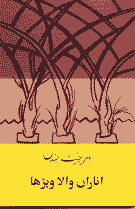 |
 |
 |
 |
|
POETRY OF AN
EXPATRIATE SIKH Aanaran wala vehrra (in
Persian script, 84 selected poems) by Amarjit Amarjit Chandan is among those Sikh writers whose main theme is the agony of the emigrants, "besides, of course, starting their experience of life in the country of their domicile." This is the evaluation of two senior Sikh writers, Kartar Singh Duggal and the late Sant Singh Sekhon which they have expressed in their book, A History of Punjabi Literature, according to which Chandan first edited a collection of short stories written by Punjabi writers settled in Britain, Do Kinarey, which "provides a peep into the working of the mind of Punjabis living abroad. The title suggests that these stories relate to the people torn between two loves, love of the land of their birth and love for making more and more money in a foreign country--at times they appear to lead sterile lives, living in the land to which they can not belong, longing to go back where can not return". This is also the main theme of Pakistan Punjabi writers settled in foreign land and Chandan is in one respect senior to many of them because his father was the first to go to Africa in 1929 and this collection has one poem about his departure from Bombay by the sea. The poem, Jahaz da ghughoo (The Ship Horn) refers to Khwaja Khizer the prophet of the seafaring Muslims. (When the boat started sailing, the passengers were nervous missing their heartbeats. They threw flowers, coconuts in the sea for the sake of god of water Khizar Khwaja.) His first taste of leaving one's land which he must have realized in his house in Nakodar where he went to Arya school and where he was more interested in hearing the last bell which marked the end of the Sanskrit period. The title of the poem is Chhutti di ghanti. In his early poetry, Chandan has many references and symbols from that part of the Punjab but does not miss the references related to his religious beliefs. In the collection under review, we find a difference as he sets out on his emotional journey of west Punjab, where lies the capital of the only nation-state of the Sikhs which was conquered by the people in whose country he is now making a living and writing poetry. Here he celebrates the new millennium on the bank of the Thames: (A Sikh father's son celebrated the dawn of a new milliennium wearing his turban. As if Nanak's face appeared on the sky by the Thames river flowing peacefully.) Nanak appears in his poetry again and again.
when during his visit to
West Punjab in Pakistan, he went to Nankana Sahib, Nanak s' birthplace, he
says: Nankana dhura dharti da, (Nankana is the center of the world, its is the womb of the word./All
roads lead to Nankana and Nankana is the path of one s' home} During Chandan s' stay in west Punjab, he visited many places on which he has written poems. For Lahore, he has four poems including on one Pir Turat Murad , a dervishe buried in the Bagh-i-jinnah. He sings in praise of Wazirabad, the Chenab, the Bela and Akram Warriach whose family lives on the river bank. Everywhere he is attracted by the rebellious spirit of the Punjab. About the Lahore's revolutionary characters,
he writes: Rattan Singh, Santokh, Sutantar This is story of Bhagat Singh and early
Punjabi Muslim, Hindu and
Sikh patriots who were considered terrorists by the All India National
Congress. Incidentally, the main theme in the history of the Sikhs is
a continuous struggle for self-preservation which sometimes took a It happened so in towards the end of the Mughal era, when the official machinery was hardening the process of its decline. The Sikhs have always been considered productive manpower. and that is why Dana labhdi heh,pani mangdi he khair manggadi heh, jarrh labhdi heh ....Aeh mairi awaz heh, mairey peo dey peo di awaz. (This is my forefather's voice seeking bread, water and wishing good for all. It seeks its root). |